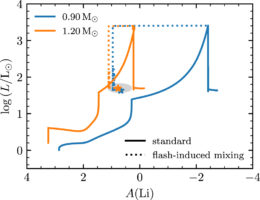As stars evolve from the red giant branch to the red clump, they accumulate lithium on their surfaces. How does this accumulation happen?
The Red Giant Branch…
Stars with less than eight solar masses, or low mass stars, live fairly placid lives. A low mass star would start off burning hydrogen in its core like all main sequence stars. Once the core hydrogen has been exhausted, the star resorts to burning hydrogen in a shell surrounding its passive core, which is now mostly helium. This stage of life is called the red giant branch (RGB) stage.
While the helium core may not be burning any material, that doesn’t mean it’s not doing anything! The sheer mass of the core means that it collapses in on itself to the point that the only thing holding it up against gravity is something called electron degeneracy — you can’t fit more than one electron in a space meant for only one electron.

A qualitative stellar evolution track going all the way to the horizontal branch. A low-mass star would begin its life somewhere on the main sequence line before moving up the red giant branch, undergoing helium flashes, and moving on to the horizontal branch. Click to enlarge. [Richard Pogge]
…and the Red Clump
This standoff doesn’t last forever though, as conditions become ideal for helium to ignite and start core burning again. This helium ignition is called a helium flash. The star is now at the horizontal branch stage, where it continues to burn hydrogen in a shell around the helium-burning core.
Multiple helium flashes can occur as the star transitions to the horizontal branch, but the first is the strongest. Cooler horizontal branch stars appear red and tend to cluster in a particular region in brightness–temperature space, aptly called the red clump (RC).
Observations of RGB and RC stars have found that RC stars have more lithium on their surface than RGB stars do. This suggests some enriching process — a process that results in more heavy elements being present in a region — occurs between the RGB and the RC stages. To investigate what could be behind this enriching, Josiah Schwab (University of California, Santa Cruz) used stellar evolution models combined with our knowledge of how material moves in stars.
Mixing Things Up

Luminosity versus lithium abundance for evolving stellar models with two different starting masses: 0.9 solar mass (blue) and 1.2 solar masses (orange). The plot shows both standard models with no mixing (solid lines) and models that assume mixing from the helium flash (dashed lines). The stars indicate where the red clump stars occur in the mixing model. The gray ellipse surrounding the stars shows the expected location of red clump stars based on observations. [Schwab 2020]
Schwab suggested the first helium flash that happens between the RGB and RC stages can trigger internal waves that mix material in the star. In some stars, this mixing would deplete lithium, but with simulations Schwab showed that the opposite happens as stars transition from the RGB to the RC, enhancing the amount of lithium present at the star’s surface.
An observational check for this flash-induced mixing would be to determine lithium abundances for stars that are just beginning to evolve from the RGB to the RC, since the first helium flash occurs right at the start of this transition. More detailed stellar models will also be useful, but for now it seems the core of this mystery is solved!
Citation:
“A Helium-flash-induced Mixing Event Can Explain the Lithium Abundances of Red Clump Stars,” Josiah Schwab 2020 ApJL 901 L18. doi:10.3847/2041-8213/abb45f
